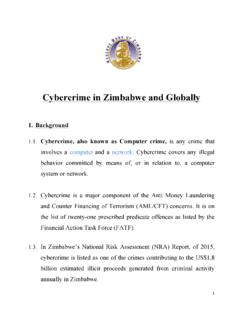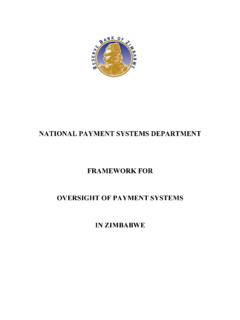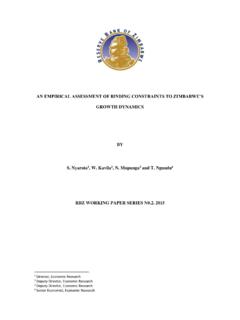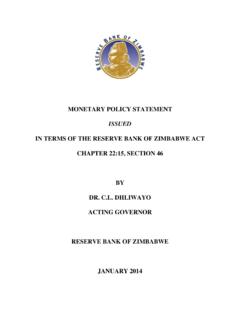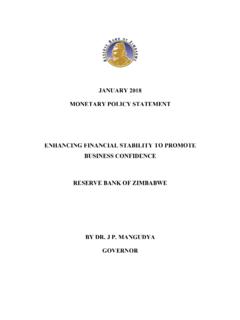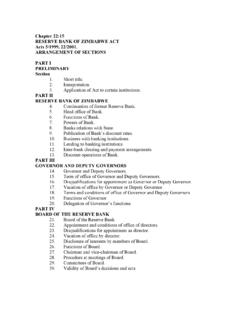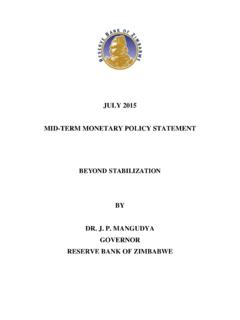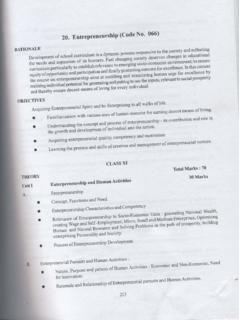Transcription of UNLOCKING VALUE THROUGH PRIVATISATION …
1 UNLOCKING VALUE THROUGH PRIVATISATION OF targeted public ENTERPRISESSUPPLEMENT TO THE JANUARY 2007 MONETARY POLICY REVIEW STATEMENT 31 JANUARY 2007 National Railways of ZimbabweAir ZimbabweTelOne HeadQuartersCold Storage Company OF 2 PRIVATIZATION 4 HOW DOES PRIVATIZATION DIFFER FROM COMMERCIALIZATION 5 BENEFITS OF PRIVATIZATION OF public 5 ZIMBABWE S PRIVATIZATION 7 SUCCESS STORIES OF THE ZIMBABWE PRIVATIZATION 8 DAIRIBORD ZIMBABWE LIMITED S PRIVATIZATION 8 TURNAROUND 9 COMMERCIALIZATION STAGE: 1994 TO 9 THE COTTON COMPANY OF ZIMBABWE 10 TURNAROUND 10 BENEFITS OF 10 OTHER COUNTRIES 10 CONDITIONS PRIOR TO 11 PRIVATIZATION 11 BENEFITS OF PRIVATIZATION THE CASE FOR 11 LESSONS FROM 12 INSTITUTIONAL SET 12 METHODS OF 12 BENEFITS OF PRIVATIZATION THE CASE FOR 13 METHODS 13 BENEFITS OF PRIVATIZATION THE CASE FOR 13 SUMMARY OF OTHER COUNTRY 13 PRIVATIZATION INERTIA AND IMPLEMETATION 16 PRIVATIZATION AND FOREIGN EXCHANGE 17 PRIVATIZATION 18 CORE PRINCIPLES ON 19 RECOMMENDED PRIVATIZATION 19 FAIR VALUE 21 RECOMMENDED STRATEGIC 21 SUCCESS 232 INTRODUCTION1
2 Governments across the world are involved in business enterprise and wealth creationactivities, in partnership with the private sector. There is, however, considerablevariation in the scope and scale of Government involvement in the production andmarketing of goods and services from country to s involvement in the economy reflects the desire to mitigate againstthe effects of market imperfections and the attendant distributional effects. Arecurring theme has been the need to cushion the vulnerable groups in society fromthe excesses of market forces, THROUGH deliberate welfare redistribution measures,such as subsidies and related , Governments have, thus taken up strategic stakes in various sectorsof the economy to influence and guide economic activity, particularly the productionand marketing of goods and Governments have, however, significantly scaled down on direct businessenterprise, preferring to concentrate on the core Government business of providingsocial welfare services such as health and education, as well as national security.
3 Peace and stability. This has been achieved mainly THROUGH extensive divesture andpublic enterprise reforms, in many Sub Saharan African economies and other partsof the Zimbabwe, since independence in 1980, the Government gained extensive stakesin various key sectors of the economy, such as agriculture, manufacturing and was in addition to the public enterprises that were already operating directlyunder the various Ministries. Government involvement in business extended to allmajor areas of economic activity - industry THROUGH IDC, mining THROUGH the MineralsMarketing Corporation of Zimbabwe, agriculture THROUGH ARDA and a number ofmarketing institutions such as GMB and AMA, the banking sector, retail and tourism,among the Economic Structural Adjustment Program years (1991-1995),Government undertook a public enterprise reform process designed to unlock valuethrough disposal of public entities and commercialization.
4 Under the parastatalreform framework, entities such as Dairibord Zimbabwe Limited (DZL), CottonCompany of Zimbabwe (Cottco) and CBZ Holdings were privatized, as Governmentdisposed its controlling shareholding. The privatized entities have since continuedto make significant contribution to the economy, generating increased output, foreignexchange and is in recognition of the positive contribution of privatization that there is need toreview the current range of public enterprises and Government shareholding indifferent sectors of the economy, with a view to UNLOCKING VALUE THROUGH undertakingfurther privatization and disposal of targeted this strategy, the country would stand to benefit, not only from relievedburden on the fiscal budget.
5 But also THROUGH the effective defense of the externalvalue of the Zimbabwean dollar on the back of the foreign exchange to be raisedthrough 1A shows the list of major public enterprises where Government has100% 1A: LIST OF PARASTATALS WITH 100% GOVERNMENTSHAREHOLDING4 TABLE 1B: GOVERNMENT STAKE THROUGH RBZ SHAREHOLDINGPRIVATIZATION DEFINED10 Privatization is defined as the transfer of enterprise ownership and control from thepublic to the private sector. The transfer techniques can take the form of disposal ofan enterprise to a strategic investor, a public offer, joint venturing, liquidations,employee/management buyouts or a combination of some or all the entails the transfer to the private sector of activities and operations ofcompanies hitherto run by the Government.
6 This definition applies to enterprisesalready owned by the Government and to new projects implemented by the carrying out such transfers, the three essential components involved responsibility, (with or without liabilities) or the rights to use assets; DOES PRIVATIZATION DIFFER FROMCOMMERCIALIZATION AND RESTRUCTURING13 Commercialization implies that the Government retains control of the , the organization is structured in such a way that it operates as a viablecommercial entails restructuring of the enterprise, redefining its operations and structuresso that it operates along commercial lines. Commercialization has tended to precedeprivatization and has been viewed as an initial stage in the privatization an effort to ensure that the public entities operate viably, the Reserve Bank ofZimbabwe established a Parastatal Re-orientation Programme.
7 Notable benefits fromthat intervention include improvements in efficiency by the National Railways ofZimbabwe (NRZ), and Zimbabwe United Passenger Company (ZUPCO), whilebenefits on other parastatals are expected to be realized over the outlook rationale of such an initiative was to put these institutions into a sound footingand prepare them for smooth OF PRIVATIZATION OF public ENTERPRISESFOREIGN EXCHANGE INFLOWS16 Increased foreign exchange inflows could be realised THROUGH the participation offoreign investors in joint ventures and strategic partnerships. The improved foreigndirect investment inflows, coupled with increased access to offshore lines of creditwould avail more foreign exchange resources, critical for economic recovery andsustained growth and PERFORMANCE17 Privatization is expected to improve efficiency and productivity of privatized will be promoted THROUGH several means, which include introduction andenhancement of VALUE addition.
8 Further efficiency gains are realized throughcommercially driven structures, free from civil service The engagement of private strategic partners is also likely to bring the much neededexpertise and leads to diffusion of technology. This significantly improves theefficiency of these enterprises, as well as increasing capacity utilization. Further,technology transfer would underpin factory refurbishment and increase THE ADMINISTRATIVE AND FINANCIALBURDEN ON GOVERNMENT19 Privatization is also aimed at relieving financial and administrative burden fromGovernment in undertaking, maintaining and supervising public entities.
9 The policyis, thus, designed to relinquish management to the private sector and allow theGovernment to concentrate on traditional functions such as facilitating growth,welfare distribution objectives and maintaining peace, security, law and order. Thiswould result in decreased budget deficit and revenue the fiscal drain by parastatals .20In the case of Zimbabwe, over the years, many parastatals have continued to imposea significant burden on the fiscus, a position which has undermined the quickturnaround of the ECONOMIC GROWTH21In the context of facilitating economic growth, privatization provides opportunitiesfor the private sector to expand its role in economic productivity and commercial and profit orientation of the private sector provides impetus forfurther growth.
10 THROUGH higher efficiency gains and profits deployment, Governmentobtains additional revenue to finance other socioeconomic development also improves capacity utilization, thereby enhancing economic public enterprises are currently operating below 40%, which is directlyretarding the capacity of the private sector to is a symbiotic relationship between the performance of parastatals and growthof the rest of the economy. For example, an inefficient ZESA will cripple the wholeindustry including major sectors such as manufacturing, agriculture, mining andtourism. On the other hand, problems at Hwange will undermine electricitygeneration, steel production at ZISCO, tobacco curing, mineral processing andgeneral indusrial IN INVESTMENT AND EXPORTPOTENTIAL24 Joint venture initiatives with foreign partners are likely to improve access tointernational capital markets.

